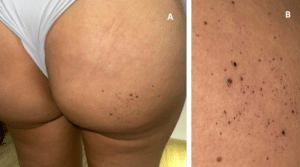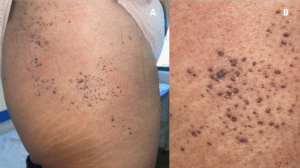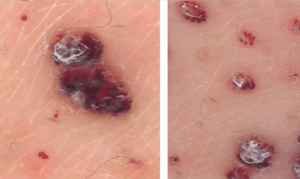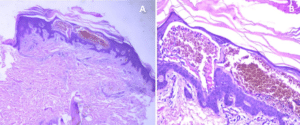Eduardo Garzón Aldás1*, Jennifer Granizo Rubio2, Xavier Garzón Garzón3
1Clinical Dermatologist /Dermatopathologist, Clínica Dermatológica Garzón, Ecuador
2Dermato-Oncologist / Surgery Dermatologist, MD Associated Hospital Metropolitano, Ecuador
3Medical Resident, Clínica Dermatológica Garzón, Ecuador
*Correspondence author: Eduardo Garzón Aldás, Clinical Dermatologist /Dermatopathologist, Clínica Dermatológica Garzón, Ecuador;
Email: [email protected]
Published Date: 30-11-2023
Copyright© 2023 by Garzon Aldas E, et al. All rights reserved. This is an open access article distributed under the terms of the Creative Commons Attribution License, which permits unrestricted use, distribution, and reproduction in any medium, provided the original author and source are credited.
Abstract
The angiokeratomas are vascular malformations histologically characterized by the presence of dilated surface capillaries with overlying hyperkeratosis, there are five types clinically recognizable. The nevoid circumscriptum angiokeratoma is an unusual type of angiokeratoma located mainly in buttocks or thighs showing a unilateral distribution. We present three new female cases of this uncommon pathology.
Keywords: Circumscribed Nevoid Angiokeratoma; Vascular Malformation; Dilated Capillaries, Hyperkeratosis
Introduction
The angiokeratomas, described in 1889 by Mibeli ¸ are vascular malformations, characterized by the presence of dilated capillaries located in the superficial dermis, with ectasia and with overlying epidermis with orthokeratotic/hyperkeratosis [1,2].
There are five types of angiokeratomas: 1) Mibelli´s angiokeratoma; 2) Fordyce´s angiokeratoma; 3) Angiokeratoma Corporis diffusum; 4) Angiokeratoma Solitary; 5) Nevoid circumscriptum angiokeratoma, it is the rarest variant of angiokeratomas and clinically it is characterized by hyperkeratotic papules with vascular aspect, whose color varies between red and black-purple, mainly located on the lower limbs since birth with a segmental distribution [3-5]. However, there are reports of the onset of the disease in adulthood [6-23].
There is a male predominance of Angiokeratomas, however, Nevoid circumscriptum angiokeratoma, is more frecuent in women [2,4]. The diagnosis is made by clinical appearance, early onset, unilateral compromise and histopathological features [1,5]. The treatment is necessary if the lesions has bleeding or by cosmetical discomfort; all procedures are destructive for example: cryosurgery, electrocautery with curetagge, deep excision and different vascular laser like Dye laser [16-19]. The Nevoid circumscriptum angiokeratoma is a very rare disorder, with few cases published in the literature, only around one hundred [1-5,20]. In this paper, we have reported three typical cases of this disease in young females.
Case Report
Case 1
A 20-year-old female patient came to our office with history of multiple eruptions on her right buttock since birth. These started as blue black, purple, papules with hyperkeratotic surface, they increased in number with the passage of time. She said the lesions bleed easily with minimal friction. There was no personal or family history of any hemorraghic disorder. In the dermatological examination we found multiple, dark red to purple, hyperkeratotic, papules, ranging from 1 mm to 4 mm on the lower outer quadrant of her right buttock (Fig. 1). On palpation, these were non-tender, slightly indurated and non-compressible. On the upper quadrant of the same buttock we can see cutis marmorata. The anatomical measurements of her legs (length and circumference) were normal. Systemic examination was normal. Routine laboratory investigations did not show any abnormalities. Doppler study did not reveal any altered blood flow. Skin biopsy showed hyperkeratosis, orthokeratosis, acanthosis, papillary dermal vascular proliferation, with ectasic vessels.

Figure 1: Multiple, dark red to purple, hyperkeratotic, papules on a background of cutis marmorata. B. Lesions with vascular aspect.
Case 2
A 25-year-old female presented with multiple lesions on her lower limb over thigh and buttock with linear distribution since birth. The papules are red and purple, with hyperkeratotic surface, they increased in size and number during years. She had focal bleeding with trivial trauma. There was no personal or family history of any hemorraghic disorder. Skin examination revealed multiple purple, hyperkeratotic, papules, ranging from 1 mm to 4 mm on her thigh and buttock with segmental distribution and with underlying erythema (Fig. 2). On palpation, no changes in the texture or thickness of the skin tissue were found. Length and circumference of the legs were equal. Systemic examination was normal. Routine lab investigations were normal. Doppler study did not reveal any altered blood flow. Skin biopsy showed the same characteristics as in patient 1. In the dermoscopy we could observe many red and purple demarcated vascular lacunae with different sizes, on the surface of which, there is whitish scale (Fig. 3).

Figure 2: Hyperkeratotic, purple papules, with segmental distribution on a background of erythema; B. Detail of the papules.

Figure 3: Polarized Dermoscopy: many red and purple demarcated vascular lacunae with different sizes, there is whitish scale on its surface.
Case 3
A 38-year-old female presented to our department with multiple micro-papules on her left thigh with linear distribution since two years ago. The papules are red and purple, with hyperkeratotic surface, they increased in number during the last years. There wasn´t a personal and family history of any similar disorder. Skin examination revealed multiple purple, hyperkeratotic, papules, ranging from 1 mm to 4 mm on her thigh with linear distribution and with underlying erythema as in the patient 2 (Fig. 4). Anatomic examination of this area and systemic examination was normal. Routine lab investigations were normal. Doppler study did not reveal any altered blood flow. Skin biopsy showed the same characteristics as in the two previous patients (Fig. 5).

Figure 4: A. Linear distribution of purpule micro-papules over erythematous background; B. Zoom of these lesions.

Figure 5: A. (H_E 4x) Hyperkeratosis, orthokeratosis, acanthosis, dilated vascular vessels with evident ectasia; B. (H-E 40x) Power magnification of the vascular spaces on papilar dermis.
Discussion
The Angiokeratomas are vascular malformations that are defined as one or more dilated vessels, in the papillary dermis accompanied by acanthosis and/or hyperkeratosis. [1,2] There are five types of angiokeratomas: (a) Angiokeratoma of Mibelli in which acral lesions are present, may be associated with intense cold; (b) Angiokeratoma of Fordyce, whose location is in the genita zonel; (c) Angiokeratoma Circumscriptum (AKC), which has a nevoid behaivor with an onset in early life with zosteriform or Blashkoid distribution; (d) Adult Angiokeratoma (solitary or multiple angiokeratoma with an onset in adult life) [3-5]; (e) Angiokeratoma corporis diffusum or Anderson-Fabry disease, is a systemic glycolipidosis associated with angiokeratomas in a diffuse pattern as a result of deficiency of the enzyme ceramide trihexosidase, which generates a deposit of glycosphingolipids in vascular endothelium and smooth muscle cells [14,15]. The pathophysiology is unknown, it has been described that possibly responds to an arteriovenous fistula or by alterations of venules and lymphatic vessels secondary to repetitive mini-trauma or by venous hypertension, which would motivate the epithelial reaction, responsible of the acanthosis, papilomatosis and hyperkeratosis observed in the skin biopsy [4-6]. The development of hyperkeratosis may be associated with an expression of matrix metalloproteinase-9 in the lesion [11]. Also apply other etiological factors, such as: genetical predisposition, pregnancy, subcutaneous hematomas and tissue hypoxia [3,5]. There are reports of the association of AKC with many symdromes and other vascular malformations such as: Klippel-Trenaunay syndrome, Cobb syndrome, nevus flammeus, cavernous hemagioma and traumatic AV fistula as well as, Anderson-Fabry disease associated with angiokeratoma circumscriptum [13-15].
The worldwide prevalence of Angiokeratomas is 0.16% and there is a slight male preponderance [1,3,5]. Nevoid circumscriptum angiokeratoma, is the rarest variant of angiokeratomas, since its original description, only around 100 cases have been reported demonstrating a female preponderance in a ratio of 3:1 ratifying this, because our 3 cases were women [1,3,5,15]. On the other hand, AKC is usually developed from the childhood, however there are cases of onset in adults [23.] In our cases the first and second began in the childhood and third in the adulthood.
Clinically the AKC is characterized by affecting the lower limbs with an asymmetric linear distribution. The lesions are micro-papules and papules, which over time coalesce to form hyperkeratotic vascular verrucous plaques, in a zosteriform or Blashkoid distribution as in our patients [1-3,5,6]. But there are a few articles that report different location for example: in the neck, chest, breast buccal mucosa [8-10,22].
The diagnosis is made by clinic-pathological correlation: micropapules and papules with vascular aspect and linear distribution with microscopic findings such as, hyperkeratosis, papillomatosis and acanthosis, ectasic superficial vascular vessels limited to papillary dermis this vascular dilatation without cellular proliferation, as seen in other vascular disorder, like hemangioma (considered among the Angio producing hyperplastic tumors) , there is proliferation of mesenchymal cells tending to the formation of capillaries, this point is very important for the histological differential diagnosis [1,2,4,6,12].
Conclusion
The AKC doesn´t has spontaneous regression, therefore the lesions may be treated by destructive methods as curettage, electrocautery, cryosurgery, surgery and laser (carbon dioxide, argon laser, KTP, Dye), if these present easy bleeding or cause cosmetic discomfort [16-21]. In our cases, dye laser was done only on number 3 due to aesthetic discomfort, the other 2 cases have only been observed to see if the lesions increase or grow.
Conflict of Interest
The authors have no conflict of interest to declare.
References
- Ivy H, Julian CA. Angiokeratoma circumscriptum. StatPearls Publishing; 2023.
- Guillen-Climent S, García-Vázquez A, Silva Díaz E, Pinazo B. Angiokeratoma circumscriptum. Dermatol Online J. 2020;26(11):13030.
- Kassem YH, Backobi E, Michel C Angiokeratoma circumscriptum neviforme. Ann Dermatol Venereol. 2018;145(8-9):552-3.
- Mittal R, Aggarwal A, Srivastava G. Angiokeratoma circumscriptum: A case report and review of the literature. Int J Dermatol. 2005;44:1031-4.
- Das A, Mohanty S, Gharami RC, Chowdhury SN, Kumar P, Das NK, et al. Linear lesions in dermatology: a clinicoaetiopathological study. Clin Exp Dermatol. 2021;46(8):1452-61.
- Happle R. Capillary malformations: a classification using specific names for specific skin disorders. J Eur Acad Dermatol Venereol. 2015;29(12):2295-305.
- Abbenante D, Raone B, Baraldi C, Carpanese MA, Patrizi A. Angiokeratoma Circumscriptum naeviforme presenting as a dark warty plaque on the leg. Acta Dermatovenerologica Croatica. 2021;29(3):169-70.
- Chhabra G, Verma P. Angiokeratoma Circumscriptum Naeviforme on Trunk. J Cutaneous Medicine and Surg. 2022;26(3):311.
- Bansal A, Gupta T. Angiokeratoma circumscriptum on the breast: a case with unusual features. Ind Dermatol Online J. 2020;11(4):655-7.
- Sardana K, Koranne RV, Sharma RC, Mahajan S. Angiokeratoma circumscriptum naeviforme: rare presentation on the neck. The Australasian J Dermatol. 2001;42(4):294-5.
- Kobayashi T, Sakuroka K. A case of angiokeratoma circumscriptum: Immunolocalization of Matrix Metalloproteinase (MMP)-9. J Dermatol. 1998;25:391-4.
- Pavithra S, Mallya H, Kini H, Pai G. Verrucous hemangioma or angiokeratoma? A missed diagnosis. Ind J Dermatol. 2011;56:599-600.
- Supekar BB, Chopkar AD, Wankhade VH, Singh RP, Bhat DM, Suresh P. Klippel-Trenaunay syndrome with arterio-veno-lymphatic malformation: a rare presentation. Ind Dermatol Online J. 2020;11(3):404-8.
- Sodaifi M, Aghaei S, Monabati A. Cutaneous variant of angiokeratoma corporis diffusum associated with angiokeratoma circumscriptum. Dermatol Online J. 2004;10:20.
- Desnick RJ, Brady R, Barranger J, Collins AJ, Germain DP, Goldman M, et al. Fabry disease, an under-recognized multisystemic disorder: Expert recommendations for diagnosis, management and enzyme replacement therapy. Ann Intern Med. 2003;138:338-46.
- Nisticò S, Campolmi P, Moretti S, Del DE, Bruscino N, Conti R, et al. Nonconventional use of flash-lamp pulsed-dye laser in dermatology. Biomed Res Int. 2016;2016:7981640.
- Lorgeou A, Chiaverini C, Le Duff F, Lacour JP, Passeron T. Successful treatment of angiokeratoma circumscriptum naeviforme with long pulse alexandrite laser. J Eur Acad Dermatol Venereol. 2017;31(4):e186-e187.
- Baumgartner J, Šimaljaková M, Babál P. Extensive angiokeratoma circumscriptum-successful treatment with 595-nm variable-pulse pulsed dye laser and 755-nm long-pulse pulsed alexandrite laser. J Cosmet Laser Ther. 2016;18(3):134-7.
- Murthy AS, Dawson A, Gupta D, Spring S, Cordoro KM. Utility and tolerability of the long- pulsed 1064-nm neodymium:yttrium-aluminum-garnet (LP Nd:YAG) laser for treatment of symptomatic or disfiguring vascular malformations in children and adolescents. J Am Acad Dermatol. 2017;77(3):473-9.
- Jansen T, Bechara FG, Altmeyer P. Angiokeratomas: symptoms, diagnostics and therapy. TKT Europe-5S AB: Danderyd. 2004.
- Del Pozo J, Fonseca E. Angiokeratoma circumscriptum naeviforme: Successful treatment with carbon-dioxide laser vaporization. Dermatol Surg. 2005;31:232-6.
- Kang YH, Byun JH, Park BW. Angiokeratoma circumscriptum of the buccal mucosa: a case report and literature review. J Korean Assoc Oral Maxillofac Surg. 2014;40:240-5.
- Grewal AK, Chambers CJ, Silverstein M. A case report of adult-onset multiple angiokeratomas with zosteriform distribution. Dermatol Online J. 2018;24(10):13030-qt9644290r.
Article Type
Case Report
Publication History
Received Date: 30-10-2023
Accepted Date: 23-11-2023
Published Date: 30-11-2023
Copyright© 2023 by Garzon Aldas E, et al. All rights reserved. This is an open access article distributed under the terms of the Creative Commons Attribution License, which permits unrestricted use, distribution, and reproduction in any medium, provided the original author and source are credited.
Citation: Garzon Aldas E, et al. Circumscribed Nevoid Angiokeratoma: Report of Three New Cases. J Dermatol Res. 2023;4(3):1-6.

Figure 1: Multiple, dark red to purple, hyperkeratotic, papules on a background of cutis marmorata. B. Lesions with vascular aspect.

Figure 2: Hyperkeratotic, purple papules, with segmental distribution on a background of erythema; B. Detail of the papules.

Figure 3: Polarized Dermoscopy: many red and purple demarcated vascular lacunae with different sizes, there is whitish scale on its surface.

Figure 4: A. Linear distribution of purpule micro-papules over erythematous background; B. Zoom of these lesions.

Figure 5: A. (H_E 4x) Hyperkeratosis, orthokeratosis, acanthosis, dilated vascular vessels with evident ectasia; B. (H-E 40x) Power magnification of the vascular spaces on papilar dermis.


